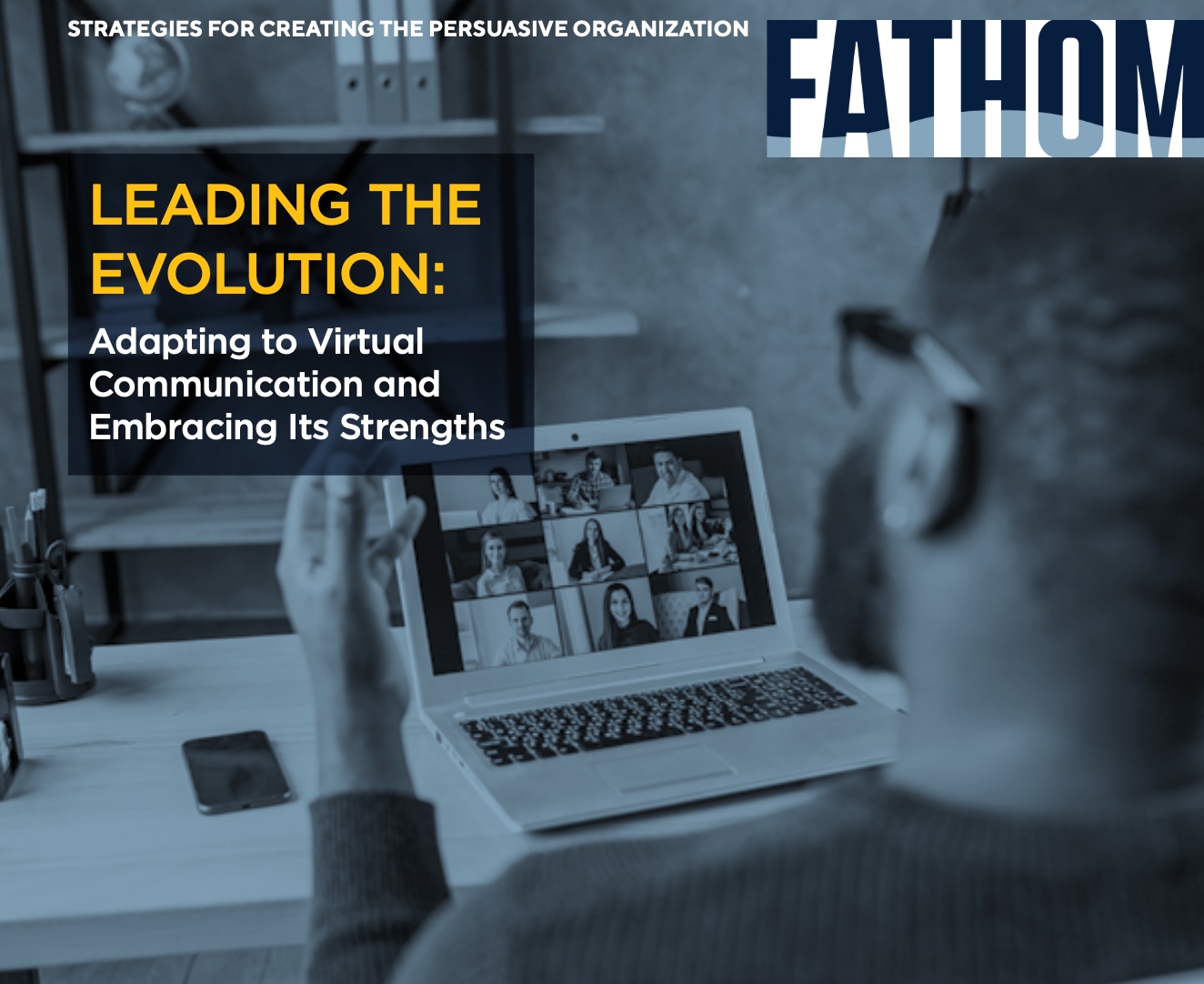Read this issue in its original magazine format.
Leading The Evolution

A year ago, businesses faced a challenge like no other. The COVID-19 pandemic brought lockdowns, large- scale transition to working at home, and an overnight moratorium on business travel. Airports idled. Employees, co-workers, and clients lived in tiny boxes on the screen. As the weeks dragged on, what became clear was that businesses that were going to survive— or, even, thrive—in this new environment were those with strong, creative, nimble leadership who saw that it wasn’t enough to just take the normal standards of business operation and move them online. And nowhere was that more apparent than in the realm of communication.
As we move forward and see a near future when businesses return to in-person work, or a hybrid of in-person and remote work, strategically astute businesses will continue to apply the lessons forced upon us during the pandemic. When used well, virtual communication can add significant value to business operations, even when it is not strictly necessary.

But best practices on-line do not always correspond to best practices off-line; the skills needed to extract the most benefit from virtual encounters are not necessarily instinctual. And not all virtual communication works as readily in an in-person or hybrid environment. Leadership must identify strategies for virtual communication and create actionable plans to cascade those strategies throughout the organization. Investing in infrastructure and training will be crucial, as will be ongoing feedback and modeling. Embedding virtual communication into business practices and continuing to accrue value from it will require thoughtful, deliberate implementation from the very top.
Pre-pandemic, many of the tools of virtual communication were available and becoming ever more user-friendly, accessible, and reliable, thanks to advances in technology and communication infrastructure. Companies were adding greater remote-working capacity to their ranks; in 2018, a study showed that 70 percent1 of professionals across the globe worked remotely at least one day a week.

“We found massive, massive improvement in performance — a 13% improvement in performance from people working at home,” says Nicholas Bloom2, a Stanford Graduate School of Business professor who ran a rigorous two-year study of a large Chinese firm transitioning to remote work.
Among its benefits:
- Cost savings: For businesses with far-flung offices or clients across the globe, virtual communication allows “face-to-face” meetings without engaging the cost of a flight, hotel, or car rental.
- Efficiency: The instant accessibility of meetings creates greater ease in scheduling and opens up time that might be spent in physically moving from office to office or client to client.
- Greater agility and control in meetings: With video conferencing, bringing in other people, documents, or reference material can be accomplished quickly and without disruption. Conversations can be recorded, for ease of reference and for the benefit of employees unable to make the original meeting. And participation can be more fluid—either verbal or in the chat window—and controllable, with the meeting host able to manage how the audience can chime in.
- Reduced waste: Screen-sharing replaces handouts, eliminating paper waste and printing costs.
- Work-life balance: Obviously, this aspect had less value during the pandemic; once routines such as school and regular child-care resume, remote working will again offer benefits of allowing employees to eliminate a commute and have more flexibility in their day.
Like many other evolutions, however, change came slowly until it came all at once. These benefits were available before the pandemic, yet the reality of virtual communication lagged behind its possibility. People valued the in-person experience and all the non-verbal communication assets it provided. Now, however, we’ve all been forced to adopt remote communication tools, like it or not. While some felt discomfort at moving every interaction online—and some continue to wish for more in-person communication—others have adapted to the virtual environment and begun to customize it to extract greater benefits both for themselves and for their companies. Either way, we’ve all become familiar with the rhythms of virtual meetings, client visits over video, and office chatter served over IM. We may not always want to work virtually, but now we know we can.
Organizationally, companies have seen the value in shrinking office space, offering employees greater flexibility and control over their schedules, and reducing travel. Barriers of distance have fallen, so that companies can reach out to talent and clients that may have been inaccessible previously. Even as gathering and travel become safe options again, many companies can and should choose to maintain virtual communication, whether that means a hybrid work environment or remote external communications.
As Ethan Murray observed in the Harvard Business Review, virtual communication, when used well, can be used to draw greater creativity and collaboration from team members. He notes one organization was able to design and launch a new business line more quickly and effectively using on-line collaboration tools. “A major reason for this success was that the combination of video, voice, chat, and collaboration tools created more opportunities for all team members to contribute, rather than be drowned out by those with loud voices or a forceful presence — or if they simply missed the session because they couldn’t fly in. With greater representation in the virtual room, teams were able to realize better and more holistic solutions in a way that just wasn’t happening before,” he writes.3 “And the outputs were instantly well-formatted and digital, so they could be immediately used in reports and documentation — as opposed to another cryptic whiteboard photo.”
But this kind of strong virtual communication doesn’t just happen: it needs to be implemented thoughtfully, trained for well, and used at the highest levels of the organization in order to succeed.
When can virtual communication go wrong? By far the most common and most harmful mistake is to treat virtual communication as if it were in-person communication conducted over the screen. Without deliberate, careful thought into how to adapt and modify for this mode of communication, remote work is bound to fail.
More specifically, corporate leaders need to be aware of the pitfalls of remote communication:
- Technology issues: Without adequate training, employees may experience difficulty adapting to online technologies. Most of us had a crash course last year but continuing to find new and better opportunities in remote communication will require ongoing training, particularly as technologies emerge with both new potential and new hurdles to use. In addition, businesses will need to assess their tech infrastructure, to make sure that they can support their current and future technology in a way that reduces glitches or slowdowns.
- Maintaining professionalism: Joining a meeting from the comfort of your home can be gratifying, but it can also make certain unprofessional behaviors that would never occur in person feel permissible. It’s unlikely that employees would feel comfortable leaving the room in the middle of a meeting or carrying on a conversation with someone else in the room during a presentation but turning off your camera or engaging in the chat window are common practice on-line.
- Engagement: When we are all gathered around a conference table, it can be easy to see who is participating and who is hanging back; well- practiced techniques allow a meeting leader to draw those observers into the conversation. In a virtual meeting, it can be harder to track who is reticent to speak or even completely checked out, and different strategies must be employed to increase participation.
- Screen fatigue: For many people, the lack of non- verbal cues during video calls and the fractured aspect of the screen makes a virtual meeting more exhausting than the same meeting held in person. Without careful attention, group meetings can become both siloed—undermining productivity— and an energy drag, writes4 Julia Sklar. “For some people, the prolonged split in attention creates a perplexing sense of being drained while having accomplished nothing. The brain becomes overwhelmed by unfamiliar excess stimuli while being hyper-focused on searching for non-verbal cues that it can’t find.” (On the other hand, Sklar points out, those who struggle to interpret non- verbal cues, such as those with autism, can find virtual communication liberating.)

To address all of these potential drawbacks, the key is to adapt and innovate. Now that we’ve moved past the point of crisis, the approach to virtual communication should perceive the opportunity within the challenge: to discover productive strategies that capitalize on the benefits of remote communication while minimizing their difficulties. It’s rare to get the chance to rethink your business from the ground up, and remote communication offers significant prospects for innovation for leaders willing to take advantage of them.
What are the principles of leadership that take advantage of virtual communication? Importantly, leadership across remote or hybrid workplaces must achieve a balance: clear and compelling, but also responsive and agile. A McKinsey and Company survey found that leaders in remote work environments who were supportive and caring, employee-focused, and creative and entrepreneurial were considered more effective than those who were authoritative, consultative, or promoted internal competition. While some of this shift in behavior has to do with organizational practices (such as converting siloed teams to more cross-functional cells), it also has to do with communication: eliminating extraneous meetings, ensuring clear communication pathways to align goals, and making progress more visible.
Successful virtual communication starts with the articulation of best practices that set standards but remain responsive to individual needs. As virtual communication becomes a key part of your corporate strategy, it is more important to make clear to every member of the team the expectations for behavior, engagement, and practices across virtual communication. At the same time, recognize issues of access and accessibility that may affect some employees, and make clear your willingness to address these issues individually.
Creating a repeatable process around virtual communication is a crucial tool as well. As we discussed in our last issue6, a repeatable, or standard work, process in communication requires three areas of effort from leadership:
- Mandate the practices you expect your team to implement, institute metrics for success, and give feedback on their execution.
- Model the process you’d like to see, so that your commitment to these practices can be seen as well as heard.
- Reinforce the mandate and your modeling with training to support improvement—perhaps especially important in communication that uses ever-evolving technology.
With a clear process put in place, it also becomes easier to clearly identify specific areas for improvement. Make mistakes an opportunity for learning and celebrate progress. Provide feedback consistently—especially important when people are working at home, where their efforts are more likely to feel isolated or invisible.
Most important, as the virtual landscape shifts rapidly in response to new technologies and applications, stay flexible and avoid complacency. A practice that makes sense one day may need to be modified the next. Managing how people interact in a hybrid environment will be different than all in-person or all remote, and management should be prepared to have a process in place for feedback, a consistent set of expectations, and a clear plan for assessing progress and creating actionable steps to improve.
In our next issue, we’ll look more closely at some strategies and best practices for virtual communication. But even before taking that step, it may be valuable to spend time considering the mission, values, and priorities for your organization that would be served best with virtual communication. Setting out a clear vision of where you want to be will help you understand better how to get there. You might also consider canvassing your employees to understand what is working well, what areas feel underdeveloped, and how they might implement new technologies or techniques for virtual work. Creating a deliberate process for feedback and buy-in will increase engagement and improve outcomes as you create new ways of working.
As Benjamin Franklin put it, “Out of adversity comes opportunity.” Our opportunity now is to imagine an organization that strategically and effectively wields virtual communication to become more efficient, more agile, and more creative. That organization can amplify the value that virtual communication presents, mitigate its challenges, and face the future with new tools for success.
—

Explore other Issues of FATHOM: Strategies for Creating the Persuasive Organization
- The Mistake of Meetings: FATHOM Issue 1 (2019)
- Establishing Repeatable Performance in Communication: FATHOM Issue 2 (2020)
- Adapting to Virtual Communication and Embracing Its Strengths – FATHOM Issue 3 (2021)
- Best Practices for Strong Virtual Communication – FATHOM Issue 4 (2021)
- The Biggest Roadblock to Organizational Success: Poor Internal Communication: FATHOM Issue 5 (2022)
- Communicating to Belong: FATHOM Issue 6 (2023)
- Building Communication with the Next Generation: FATHOM Issue 7 (2024)
- How to be Heard in a Noisy World: FATHOM Issue 8 (2024)
Sources:
- https://www.cnbc.com/2018/05/30/70-percent-of-people-globally-work-remotely-at-least-once-a-week-iwg-study.html
- https://www.gsb.stanford.edu/insights/why-working-home-future-looking-technology
- https://hbr.org/2020/10/the-next-generation-of-office-communication-tech
- https://www.nationalgeographic.com/science/2020/04/coronavirus-zoom-fatigue-is-taxing-the-brain-here-is-why-that-happens/
- https://www.mckinsey.com/featured-insights/coronavirus-leading-through-the-crisis/charting-the-path-to-the-next-normal/meet-your- new-leaders-supportive-creative-and-employee-focused
- https://thelatimergroup.com/fathom/
- https://www.linkedin.com/pulse/reimagining-our-way-working-role-workspace-technology-suresh-kumar





Comments